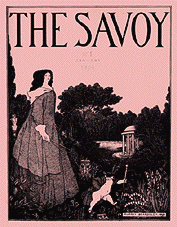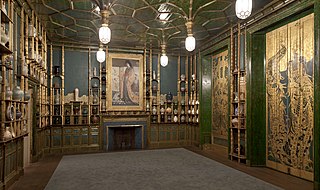
Aestheticism was an art movement in the late 19th century that valued the appearance of literature, music, fonts and the arts over their functions. According to Aestheticism, art should be produced to be beautiful, rather than to teach a lesson, create a parallel, or perform another didactic purpose, a sentiment best illustrated by the slogan "art for art's sake." Aestheticism flourished in the 1870s and 1880s, gaining prominence and the support of notable writers such as Walter Pater and Oscar Wilde.

Aubrey Vincent Beardsley was an English illustrator and author. His black ink drawings were influenced by Japanese woodcuts, and depicted the grotesque, the decadent, and the erotic. He was a leading figure in the aesthetic movement which also included Oscar Wilde and James McNeill Whistler. Beardsley's contribution to the development of the Art Nouveau and poster styles was significant despite his early death from tuberculosis. He is one of the important Modern Style figures.
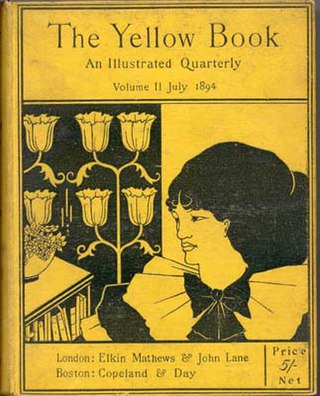
The Yellow Book was a British quarterly literary periodical that was published in London from 1894 to 1897. It was published at The Bodley Head Publishing House by Elkin Mathews and John Lane, and later by John Lane alone, and edited by the American Henry Harland. The periodical was priced at 5 shillings and lent its name to the "Yellow Nineties", referring to the decade of its operation.

Arthur William Symons was a British poet, critic, translator and magazine editor.

Ernest Christopher Dowson was an English poet, novelist, and short-story writer who is often associated with the Decadent movement.

The Rhymers' Club was a group of London-based male poets, founded in 1890 by W. B. Yeats and Ernest Rhys. Originally not much more than a dining club, it produced anthologies of poetry in 1892 and 1894. They met at the London pub ‘Ye Olde Cheshire Cheese’ in Fleet Street and in the 'Domino Room' of the Café Royal.
Teleny, or, The Reverse of the Medal, is a pornographic novel, first published in London in 1893. The authorship of the work is unknown. There is a consensus that it was an ensemble effort, but it has often been attributed to Oscar Wilde. Set in fin-de-siècle Paris, its concerns are the magnetic attraction and passionate though ultimately tragic affair between a young Frenchman named Camille Des Grieux and the Hungarian pianist René Teleny. The novel is one of the earliest pieces of English-language pornography that focuses explicitly and near-exclusively on homosexuality. Its lush and literate, though variable, prose style and the relative complexity and depth of character and plot development share as much with the aesthetic fiction of the period as with its typical pornography.

The Decadent movement was a late-19th-century artistic and literary movement, centered in Western Europe, that followed an aesthetic ideology of excess and artificiality.

Venusberg is a motif of European folklore rendered in various legends and epics since the Late Middle Ages. It is a variant of the folktale topos of "a mortal man seduced by the fairy queen visits the otherworld". In German folklore of the 16th century, the narrative becomes associated with the minnesinger Tannhäuser who becomes obsessed with worshipping the goddess Venus.
The Symbolist Movement in Literature, first published in 1899, and with additional material in 1919, is a work by Arthur Symons largely credited with bringing French Symbolism to the attention of Anglo-American literary circles. Its first two editions were vital influences on W. B. Yeats and T. S. Eliot—a note that, for nothing else, would assure its historical place with the most important early Modernist criticism. Richard Ellmann has contributed an Introduction to most modern editions.
Leonard Charles Smithers was a London bookseller and publisher associated with the Decadent movement of the late 19th century.
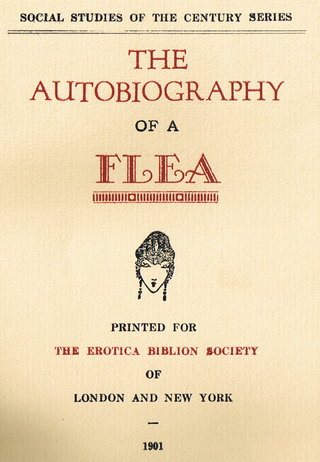
The Erotika Biblion Society General Germany was a pornographic publishing imprint in Victorian London formed by Harry Sidney Nichols and Leonard Smithers in 1898. They formed their name from the 1898 nonfiction treatise of the same name under the penmanship of the Comte de Mirabeau. One of their most notable publications was Teleny, or The Reverse of the Medal, thought to have been written by Oscar Wilde. The venture ended in 1907, after the death of Smithers.
Charles Hirsch was a French bookseller in Victorian London who sold French literature and ran a clandestine trade in expensive pornography. He was involved in the writing of Teleny, or The Reverse of the Medal, an early work of homosexual pornography, and described Oscar Wilde's involvement in its compilation.
George Reginald Bacchus (1874–1945) was an English writer. He wrote a number of erotic books published by the Erotika Biblion Society.

Guy Thorne was the pen name of Cyril Arthur Edward Ranger Gull, a prolific English journalist and novelist best known for his novel When It Was Dark: The Story of A Great Conspiracy (1903). He also wrote under the names C. Ranger Gull and Leonard Cresswell Ingleby.
The Rodiad is a pornographic poem on the subject of flagellation published by John Camden Hotten in 1871, although falsely dated to 1810. It was falsely ascribed when printed to George Colman the Younger. Its author was Richard Monckton Milnes. Henderson places it in The Library Illustrative of Social Progress published around 1872 but it is not in the list of Henry Spencer Ashbee.

The Climax is an 1893 illustration by Aubrey Beardsley (1872–1898), a leading artist of the Decadent (1880-1900) and Aesthetic movements. It depicts a scene from Oscar Wilde's 1891 play Salome, in which the femme fatale Salome has just kissed the severed head of John the Baptist, which she grasps in her hands. Elements of eroticism, symbolism, and Orientalism are present in the piece. This illustration is one of sixteen Wilde commissioned Beardsley to create for the publication of the play. The series is considered to be Beardsley's most celebrated work, created at the age of 21.
The Gift of Harun Al-Raschid, written in 1923, is a poem by the Irish poet William Butler Yeats, first published in 1924 in the American journal The Dial in a collection of The Cat and the Moon and Certain Poems. The poem was then published in his prose book A Vision in 1925 and was included in Yeats's collection of The Tower, which was published in 1928.
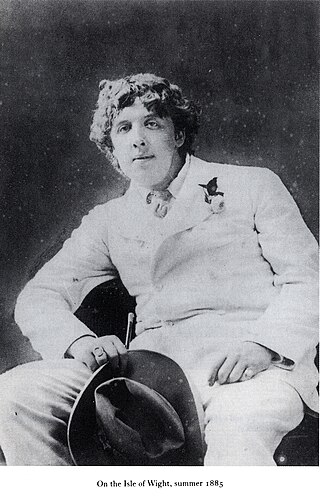
"The Harlot's House" (1885) is a 36-line poem in terza rima by Oscar Wilde. It touches on the issue of prostitution in a style which can be seen as either Aesthetic or Decadent. It is considered one of Wilde's finest poems, and has been set to music several times.
William Thomas Horton was a Belgian-born English artist, writer, and occultist connected to the symbolist and aestheticist movements. His drawings were largely unpublished during his lifetime.
